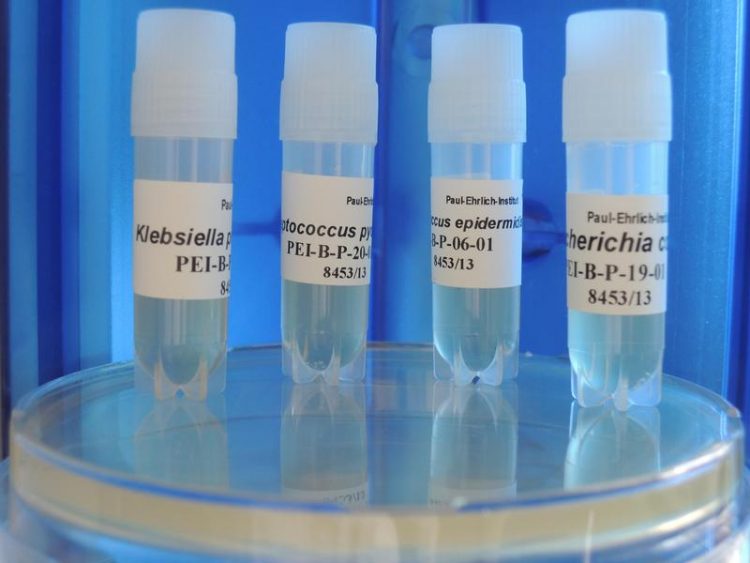Safe blood products – PEI develops WHO-reference materials for platelet concentrates

WHO-reference materials for platelet concentrates Source: PEI
The first step in the collection of blood donations alone – the act of piercing through the donor’s skin which is covered with bacteria – involves the potential risk of pathogens entering the blood donation. For this reason, various measures are in place to ascertain that the blood donation is safe throughout the entire blood donation procedure. These include donor screening, effective disinfection of the punctured site of the skin, and the testing of blood products for possible pathogens.
One of the prerequisites for the reliability of the detection methods used in testing for possible pathogens is their validation by means of suitable reference materials (validated test strains). These are comparable with calibration weights of weighing scales. To serve as reliable reference materials, the test strains survive, and must be replicable under the storage conditions determined.
In addition, for a quantitative validation, it is necessary to know the live pathogen count. To guarantee this, a collaborative trial was performed under the supervision of the Paul-Ehrlich-Institut, to which 14 laboratories contributed, and the results of which have now enabled the Paul-Ehrlich-Institut to extend the repository of WHO reference materials by the following bacterial strains:
• Bacillus cereus PEI-B-P-57
• Bacillus thuringiensis PEI-B-P-07
• Enterobacter cloacae PEI-B-P-43
• Morganella morganii PEI-B-P-91
• Proteus mirabilis PEI-B-P-55
• Pseudomonas fluorescens PEI-B-P-77
• Serratia marcescens PEI-B-P-56
• Staphylococcus aureus PEI-B-P-63
• Streptococcus dysgalactiae PEI-B-P-7
• Streptococcus bovis -reklassifiziert als Streptococcus gallolyticus.
As early as 2011 the Paul-Ehrlich-Institut, in collaboration with the “International Society of Blood Transfusion” (ISBT) developed the first bacterial reference panel of four strains (Staphylococcus epidermidis PEI-B-P-06, Klebsiella pneumoniae PEI-B-P-08, Streptococcus pyogenes PEI-B-P-20 und Escherichia coli PEI-B-P-19) in a worldwide collaborative trial. The full genome sequence of these strains is now known and is publicly available [1] at the American Society for Microbiology (ASM)
All 14 reference materials are cultured by the Paul-Ehrlich-Institut by means of a method especially developed for this purpose and provided as deep-frozen bacterial suspension with a defined pathogen count.
“I am happy that our researchers have made an important contribution to the reliable testing of blood products worldwide through the development and provision of blood products”, said Professor Klaus Cichutek, president of the Paul-Ehrlich-Institut.
WHO Collaborating Centre at the Paul-Ehrlich-Institut
Since 2005, the Paul-Ehrlich-Institut has a WHO Collaborating Centre for the quality assurance of blood products and in vitro diagnostic devices. The work of the WHO Collaborating Centre is multifaceted. The Paul-Ehrlich-Institut initiates and organises standardisation projects for biological reference materials and takes part in collaborative trials worldwide. Members of staff of the Paul-Ehrlich-Institut take an active part in various expert meetings and working parties of the WHO, and, together with other researchers, prepare regulatory documents (WHO Guidelines). Last but not least, the Paul-Ehrlich-Institut regularly provides the WHO in Geneva with experts as part of a secondment
Original publications:
Spindler-Raffel E, Benjamin RJ, McDonald CP, Ramirez-Arcos S, Aplin K, Bekeredjian-Ding I, de Korte D, Gabriel C, Gathof B, Hanschmann KM, Hourfar K, Ingram C, Jacobs MR, Keil SD, Kou Y, Lambrecht B, Marcelis J, Mukhtar Z, Nagumo H, Niekerk T, Rojo J, Marschner S, Satake M, Seltsam A, Seifried E, Sharafat S, Störmer M, Süßner S, Wagner SJ, Yomtovian R for the ISBT Working Party Transfusion-Transmitted Infectious Diseases (WP-TTID) Subgroup on Bacteria (2017): Enlargement of the WHO international repository for platelet transfusion-relevant bacteria reference strains.
Vox Sanguinis
DOI: 10.1111/vox.12548
[1] Mellmann A, Spindler-Raffel E, Bletz S, Prax M, Bekeredjian-Ding I (2017): Genome Sequences of the First WHO Repository of Platelet Transfusion-Relevant Bacterial Reference Strains.
Genome Announc. 2017 Jul 20;5(29)
DOI: 10.1128/genomeA.00001-17
The Paul-Ehrlich-Institut, the Federal Institute for Vaccines and Biomedicines, in Langen near Frankfurt/Main is a senior federal authority reporting to the Federal Ministry of Health (Bundesministerium für Gesundheit, BMG). It is responsible for the research, assessment, and marketing authorisation of biomedicines for human use and immunological veterinary medicinal products. Its remit also includes the authorisation of clinical trials and pharmacovigilance, i.e. recording and evaluation of potential adverse effects.
Other duties of the institute include official batch control, scientific advice and inspections. In-house experimental research in the field of biomedicines and life science form an indispensable basis for the manifold tasks performed at the institute.
The Paul-Ehrlich-Institut, with its roughly 800 members of staff, also has advisory functions nationally (federal government, federal states (Länder)), and internationally (World Health Organisation, European Medicines Agency, European Commission, Council of Europe etc.).
Abstract of the publication
https://www.ncbi.nlm.nih.gov/pmc/articles/PMC5522920/ – Full text Version of the Genome Announc publication
Media Contact
More Information:
http://www.pei.de/All latest news from the category: Life Sciences and Chemistry
Articles and reports from the Life Sciences and chemistry area deal with applied and basic research into modern biology, chemistry and human medicine.
Valuable information can be found on a range of life sciences fields including bacteriology, biochemistry, bionics, bioinformatics, biophysics, biotechnology, genetics, geobotany, human biology, marine biology, microbiology, molecular biology, cellular biology, zoology, bioinorganic chemistry, microchemistry and environmental chemistry.
Newest articles

Bringing bio-inspired robots to life
Nebraska researcher Eric Markvicka gets NSF CAREER Award to pursue manufacture of novel materials for soft robotics and stretchable electronics. Engineers are increasingly eager to develop robots that mimic the…

Bella moths use poison to attract mates
Scientists are closer to finding out how. Pyrrolizidine alkaloids are as bitter and toxic as they are hard to pronounce. They’re produced by several different types of plants and are…

AI tool creates ‘synthetic’ images of cells
…for enhanced microscopy analysis. Observing individual cells through microscopes can reveal a range of important cell biological phenomena that frequently play a role in human diseases, but the process of…





















